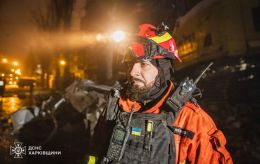Why Russia paused missile attacks on Ukraine, choosing to strike with drones every night: Expert explanation
 Photo: Air raid alert in Ukraine is announced every night over Shahed drones (Vitalii Nosach, RBC-Ukraine)
Photo: Air raid alert in Ukraine is announced every night over Shahed drones (Vitalii Nosach, RBC-Ukraine)
Russia is massively attacking Ukraine almost every night with Shahed UAVs and unidentified drones. Among the targets is Kyiv, where air raids have become more frequent, and falling debris has repeatedly caused damage to buildings.
Oleksandr Musiienko, head of the Сenter for Military Law Research, told RBC-Ukraine why Russians prefer to carry out such attacks and not massive missile strikes.
Why Russia keeps a pause in massive missile attacks
As the expert explained, Russia is constantly accumulating missiles to be able to strike.
“They also continue to accumulate ballistic missiles. Of course, they have some difficulties with that. They have already used many missiles against Ukraine. So, the Russians need time to develop the capability to recover, and it is not so easy,” Musiienko says.
From a military point of view, Russia has already completed most of its preparations to launch strikes from strategic aviation, which it has not carried out since August 26.
“In fact, there were no large-scale missile strikes during the fall. Why don't they do it? Here we need to look for not only some explanation exclusively in the military terms. One of the possible reasons is that they just want to accumulate even more missiles to intensify terror on the eve of winter and create very difficult conditions for us in the energy sector,” Musiienko said.
Drone attacks every night
As for drone attacks, the expert believes that the enemy uses them for several purposes. The first is terror against the civilian population. Including psychological terror.
“Drone attacks take place mostly at night, in the morning, when, as experts say, people have the best sleep. Accordingly, this leads to general stress and gloomy moods,” explains Musiienko.
The second reason is Russia's attempts to damage certain infrastructure facilities. And the third is disorientation, exhaustion of Ukrainian air defense, and its constant workload. As there are three waves of attacks, the expert said.
“First, they launch drones that are actually deceptive targets. These are usually drones without a combat charge. They are quite lightweight, based on foam, with a tank of up to 10 liters of fuel. And they just have to fly to draw the attention of certain air defense systems and disorient them,” Musienko says.
The second wave consists of Shahed drones mixed with drones that serve as decoys. And then in the morning, the Russians launch the Shaheds.
“Plus, we have to talk about money. Because no matter what, especially from 2025 onwards, Russia will face even more economic problems against the backdrop of this current situation. And the production of drones is cheaper than missiles,” Musiienko emphasizes.
The expert notes that drones can be produced on a larger scale at a lower cost. And this is also an argument for Moscow why it prefers Shaheds, drones, when choosing what to attack Ukraine, and the capital in particular.
Why Kyiv is among Russia's targets
According to Musiienko, one of the reasons why Kyiv is one of the targets of drone attacks is that the enemy is trying to probe the air defense systems that protect the city.
“Secondly, I want to remind you that when drones are launched, for example, from the Kursk region, it is not that far from Kyiv. Therefore, there is a geographical opportunity to do this,” Musiienko explained.
Besides, it is the capital of Ukraine, and therefore it will always be in the enemy's field of attention, no matter what, the expert adds.
“If we are talking about the impossibility of a Russian land offensive on Kyiv, then in terms of such attacks, the capital will always be in the spotlight. Because this maniacal obsession with the 'decision-making center' and so on is perfectly understandable,” the expert concluded.
Russian troops launched an Iskander ballistic missile strike in the Dnipropetrovsk region overnight, attacked the Kharkiv region with guided bombs, and launched 80 Shahed drones and unidentified drones across Ukraine.
Air defense forces operated in the Kyiv, Sumy, Odesa, Kherson, Mykolaiv, Zhytomyr, Cherkasy, Chernihiv, and Kirovohrad regions. They shot down 50 drones. Another 27 enemy drones were lost in different regions of Ukraine.
According to the Kyiv City Military Administration, the enemy used its usual tactics but again failed to achieve its goal. All drones flying towards Kyiv were neutralized. Yet, in the Desnianskyi district, debris fell in an open area. Local fires broke out, burning grass and litter. There were no casualties or damage.

